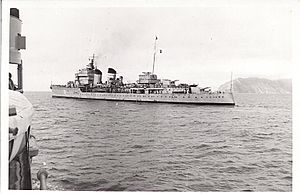Spanish cruiser Miguel de Cervantes facts for kids

Miguel de Cervantes in Cartagena, circa 1930
|
|
Quick facts for kids History |
|
|---|---|
| Name | Miguel de Cervantes |
| Namesake | Miguel de Cervantes Saavedra |
| Builder | S.E.C.N in Ferrol |
| Laid down | 27 August 1926 |
| Launched | 19 May 1928 |
| Commissioned | 10 February 1930 |
| Stricken | 1 July 1964 |
| Fate | Sold for scrap July 1964 |
| General characteristics | |
| Class and type | Almirante Cervera-class cruiser |
| Displacement | 9240 tons |
| Length | 167.62 m (549.93 ft) |
| Beam | 16.61 m (54.49 ft) |
| Draft | 5.03 m (16.50 ft) |
| Installed power | 80,000 shp (60,000 kW) |
| Propulsion |
|
| Speed | 35 knots (65 km/h; 40 mph) |
| Range | 4,950 nmi (5,700 mi; 9,170 km) @ 15 kn (17 mph; 28 km/h) |
| Armament |
|
| Notes | Could carry a Heinkel He 114 scout plane (after upgrades) |
The Miguel de Cervantes was a type of warship called a light cruiser that served in the Spanish Navy. She was named after the famous Spanish writer Miguel de Cervantes Saavedra. This ship played an important role in the Spanish Civil War, fighting on the side of the Republicans. After the war, she continued to serve in the Spanish Navy. The ship was ordered in 1926 as part of a plan to build up the navy.
Contents
Early Service and the Asturias Revolution
The Miguel de Cervantes had her first tests at sea in December 1929. She was very fast, reaching 25 knots (about 46 kilometers per hour), which was faster than the Navy needed.
In 1934, the ship, along with her sister ship Almirante Cervera, helped put down a miners' strike in Asturias. They fired at a neighborhood called Cimadevilla. The Miguel de Cervantes also worked with the battleship Jaime I to carry soldiers and supplies to Gijón.
Role in the Spanish Civil War
On July 17, 1936, the Miguel de Cervantes and another ship, the Libertad, were ordered to sail to the Strait of Gibraltar. This was just as a rebellion began in Spain. The crews of the ships decided to support the government (Republicans) instead of the rebels (Nationalists).
The Republican fleet, which included Jaime I, Libertad, Miguel de Cervantes, and seven destroyers, met near Tangier International Zone on July 20. They then blocked the Strait of Gibraltar, which is a very important waterway.
Bombardments and Blockade
On July 22, the ships fired at the city of La Línea de la Concepción. Two days later, on July 25, they also bombarded Ceuta. From then on, the city of Málaga became their main base for keeping the blockade going.
Later, on September 21, the Miguel de Cervantes left Málaga with Jaime I and five destroyers. They left the Strait of Gibraltar area to help Republican soldiers who were surrounded in Northern Spain. After this mission, they returned to the Mediterranean Sea and made their base in Cartagena.
Torpedo Attack and Repairs
On November 22, 1936, while anchored near Cartagena, the Miguel de Cervantes was hit by torpedoes. These torpedoes were fired by an Italian submarine called Evangelista Torricelli. The ship was badly damaged but was towed into port. Because of air attacks, her repairs took a long time and were not finished until April 11, 1938.
End of the War
On March 5, 1939, the Miguel de Cervantes left Cartagena with most of the Republican Navy. They sailed to Bizerta in Tunisia, arriving on March 11. The next day, the crews asked for political asylum, meaning they wanted protection in Tunisia. Most of the sailors were kept in a camp, with only a few left to guard the ships. The rest were sent to a concentration camp.
Post-War Service
After the Spanish Civil War, the Miguel de Cervantes continued to serve the Spanish Navy. In 1949, she carried Francisco Franco, who was the leader of Spain at the time, to Lisbon, Portugal. In May 1952, she transported Franco again, this time to Barcelona for a big religious event called the XXXV International Eucharistic Congress.
The Miguel de Cervantes was also one of the ships used to land troops on the African coast during the Ifni War. This was a conflict that took place in the late 1950s.
Final Years
The Miguel de Cervantes was officially removed from service on July 1, 1964. Later that month, she was sold at a public auction to be taken apart for scrap metal. She was bought for 31,680,000 pesetas, which was the currency in Spain at the time.
See also
 In Spanish: Miguel de Cervantes (1930) para niños
In Spanish: Miguel de Cervantes (1930) para niños

